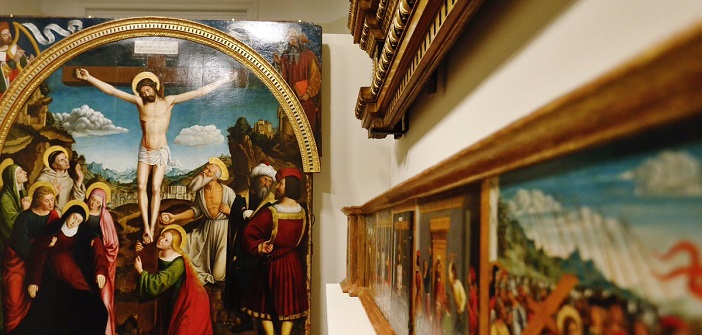After long restoration work, the altarpiece of the Crucifixion dating from 1512 has regained its splendor and was presented to the public at Ville Masséna on this eve of Good Friday.
This painting by Louis Brea has undergone several restorations. It was displayed in the church of the Cimiez monastery. In 2015, it turned out that a more extensive restoration was necessary. The painting was therefore transferred to Marseille to the interdisciplinary heritage conservation and restoration workshops.
Once restored, the work is presented at the Masséna Museum under strict hygrometric conditions, to avoid damaging it. This is precisely the reason for its presence at the Masséna Museum. To contemplate it, the room has limited access in terms of the number of people.
Work is currently being done at the Cimiez monastery before its return, still mindful of temperature concerns. It took three years from 2015 to 2018 to complete the diagnosis, research, and restoration. Since the work is done on wood, it is necessary to consider the movements, reactions of the paint, and the working of the wood, proactively to prevent the wear of time and subsequently to ensure the altarpiece is well preserved.
The work is impressive in its composition. Let’s not forget its time, the beginning of the 16th century. Five elements compose it, made of poplar wood for four of them and softwood for the fifth.
The painting represents the crucifixion of Jesus. We are in Jerusalem, Christ is agonizing and dying before his last followers. His mother is there, the mother of sorrow, as is the disciple John. One may be surprised by the costumes of the two figures on the right; their garments correspond to that Renaissance period. Among several explanations, the most probable one is that Louis Brea might have depicted the patrons of his painting. Patrons at that time often had themselves depicted in artworks.
Louis Brea was from Nice, born around 1450 and died in the same city in 1523. His father Moneto Brea was a cooper on the Rue de la Barillerie where Louis set up his workshop.
The position of his father as prior of the Black Penitents testifies to the intellectual character of this family. The public can now, while awaiting the optimum conditions of the Cimiez Monastery, view it at the Masséna Museum, open every day except Tuesday.


